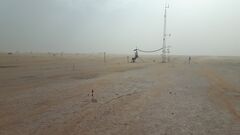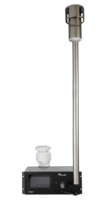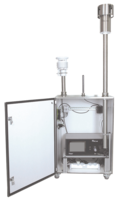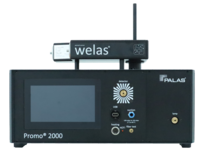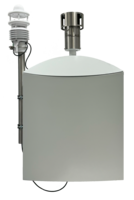Case Study | Environment
Mineral dust is a crucial yet still underestimated factor in the global climate system. It influences air quality, cloud formation, Earth’s radiation balance, and even precipitation. Yet, the processes that drive dust emissions and their climatic impacts have long remained insufficiently understood. Three international research projects — J-WADI, FRAGMENT, and WIND-O-V — have in recent years made decisive contributions to sharpening this picture.
J-WADI – Large Particles in the Spotlight of Dust Research
The J-WADI project focused on the question of how much large dust particles actually contribute to total emissions. In September 2022, extensive field campaigns were carried out in the Jordanian desert near Wadi Rum, coordinated by the Institute of Meteorology and Climate Research (IMK-TRO) at the Karlsruhe Institute of Technology (KIT). The region offered ideal conditions: vast, sparsely vegetated areas, loose sediments, and frequent dust events.
A multi-instrument strategy was applied to cover the full spectrum of particles from ultrafine to very large sizes. Central to this setup was the Fidas® 200S from Palas, an EN 16450-certified fine dust monitoring device providing high-resolution real-time data for PM1, PM2.5, and PM10. It was complemented by the welas® 2500, optimized for coarse particles above ten micrometers, and the Cloud Droplet Analyzer (CDA), which made large spherical particles and droplets measurable.
The measurements demonstrated for the first time that particles larger than ten micrometers can account for up to 90 percent of total dust mass. Particularly striking was a maximum at around 60 µm — a size class rarely considered in climate models. Moreover, particles larger than 60 µm were still detectable at several meters above ground, indicating that such large particles can be transported by strong winds across several kilometers — significantly farther than previously assumed.
The implications are substantial: Large particles alter the radiation balance, degrade local air quality, accumulate on infrastructure, and can reduce photovoltaic efficiency by up to 30 percent during major dust events. The data have already been integrated into international climate models, improving projections for both climate and air quality.
FRAGMENT – Mineralogy and Composition as Climate Drivers
While J-WADI highlighted the importance of particle size, the FRAGMENT project focused on dust composition. In September 2019, measurements were conducted in Morocco’s Lower Drâa Valley, a hotspot for freshly emitted dust. The aim was to characterize not only size distributions but also mineralogy and physical properties in detail.
Once again, the Fidas® 200S played a central role. With its ability to continuously resolve particle sizes in 63 channels between 0.2 and 19.1 µm, it provided highly accurate distributions of relevant fractions. Complementary samples were collected with impactors and samplers, then analyzed in the laboratory using scanning electron microscopy (SEM) and energy-dispersive X-ray spectroscopy (EDX).
The results revealed that feldspar particles occur far more frequently than previously assumed. Pure feldspar accounts for about 3.2 percent of dust mass, while internally mixed feldspar can reach up to 18 percent in larger particles. Feldspar is known as an efficient ice-nucleating particle and thus directly influences cloud formation. Equally important was the detection of iron oxides and hydroxides, particularly in particles smaller than 2 µm, which strongly affect the radiation budget by absorbing sunlight.
Another key finding was the role of dry deposition: Large particles are removed from the atmosphere very quickly. Even particles just 5 µm in diameter are deposited at rates of around 65 percent near the source. This means that measurements taken far from emission points systematically underestimate the share of large particles — one of the main reasons why many climate models have so far represented the true effects of mineral dust at its source only inadequately.
FRAGMENT has thus expanded scientific understanding while also providing practical insights relevant to agriculture, solar energy, and regional air quality.
WIND-O-V – Atmospheric Processes of Dust Emission
The WIND-O-V project, conducted already in 2017, investigated the mechanisms of dust emission in southern Tunisia. On the Dar Dhaoui Experimental Range — a natural dust hotspot — researchers examined the role of wind speed, thermal stratification, and turbulence.
High-resolution Palas instruments were used: the welas® 2300 aerosol spectrometer, measuring size distributions between 0.2 and 40 µm directly at the source, and the Promo® 2000, which provided time-resolved measurements that captured dynamic changes in particle fluxes. Combined with meteorological sensors and eddy covariance systems, this yielded a comprehensive picture of emission processes.
The findings were clear: Thermal stability of the atmosphere strongly influences dust release. Under unstable conditions with strong mixing, far more particles are emitted, whereas stable stratifications significantly limit emissions. Large-scale turbulence structures, such as thermals, also proved crucial as they generate local wind shear and disrupt the soil surface.
These insights are directly relevant to practice. They help improve early-warning systems for dust storms, which are vital for affected populations and aviation alike. They are also highly valuable for the solar energy sector, where dust deposition can significantly reduce photovoltaic performance.
Together, the three projects demonstrate that mineral dust is larger, more diverse, and more climatically relevant than previously thought. They show that size, composition, and emission processes must each be considered to realistically capture dust impacts on radiation balance, cloud formation, and air quality.
Thanks to high-resolution technology from Palas — from the certified fine dust monitor Fidas® 200S to versatile instruments such as welas® System and Promo® 2000, and the Cloud Droplet Analyzer (CDA) — it was possible to obtain data of unprecedented quality. These findings have already been integrated into international climate models and today contribute to more accurate dust forecasts, more reliable assessments of climate impacts, and better-targeted adaptation strategies.
Literature
J-Wadi
- Meyer, H., Kandler, K., Dupont, S., Escribano, J., Girdwood, J., Nikolich, G., … Klose, M. (2025). From fine to giant: Multi-instrument assessment of the dust particle size distribution at an emission source during the J-WADI field campaign. EGUsphere, [Preprint]. https://doi.org/10.5194/egusphere-2025-1531
Fragment
- González-Flórez, C., Klose, M., Alastuey, A., Dupont, S., Escribano, J., Etyemezian, V., … Pérez García-Pando, C. (2023). Insights into the size-resolved dust emission from field measurements in the Moroccan Sahara. Atmospheric Chemistry and Physics, 23(7177–7201). https://doi.org/10.5194/acp-23-7177-2023
- Panta, A., Kandler, K., Alastuey, A., González-Flórez, C., González-Romero, A., Klose, M., … Pérez García-Pando, C. (2023). Insights into the single-particle composition, size, mixing state, and aspect ratio of freshly emitted mineral dust from field measurements in the Moroccan Sahara using electron microscopy. Atmospheric Chemistry and Physics, 23(3861–3882). https://doi.org/10.5194/acp-23-3861-2023
WIND-O-V
- Dupont, S., Bergametti, G., Rajot, J. L., Lamaud, E., Labiadh, M., Bouet, C., … Marticorena, B. (2019). Dissimilarity between dust, heat, and momentum turbulent transports during aeolian soil erosion. Journal of Geophysical Research: Atmospheres, 124(22), 11745–11767. https://doi.org/10.1029/2019JD030736
- Dupont, S., Rajot, J. L., Lamaud, E., Bergametti, G., Labiadh, M., Bouet, C., … Marticorena, B. (2020). Comparison between eddy-covariance and flux-gradient size-resolved dust fluxes during wind erosion events. Journal of Geophysical Research: Atmospheres, 125(7). https://doi.org/10.1029/2019JD031127
- Khalfallah, B., Marticorena, B., Dupont, S., Rajot, J. L., Bergametti, G., Bouet, C., … Lamaud, E. (2020). Influence of atmospheric stability on the size distribution of the vertical dust flux. Journal of Geophysical Research: Atmospheres, 125(15). https://doi.org/10.1029/2019JD031863
- Fernandes, R., Dupont, S., Rajot, J. L., Bergametti, G., Marticorena, B., Lamaud, E., … Khalfallah, B. (2020). Origins of turbulent transport dissimilarity between dust and momentum in semi-arid areas. Journal of Geophysical Research: Atmospheres, 125(3). https://doi.org/10.1029/2019JD031085
- Dupont, S., Bergametti, G., Rajot, J. L., Lamaud, E., Labiadh, M., Bouet, C., … Marticorena, B. (2019). Scaling of dust flux with friction velocity: Time resolution effects. Journal of Geophysical Research: Atmospheres, 124(20), 10702–10718. https://doi.org/10.1029/2019JD030665
- Alfaro, S. C., Dupont, S., Rajot, J. L., Bergametti, G., Marticorena, B., Lamaud, E., … Labiadh, M. (2022). Unraveling the roles of saltation bombardment and atmospheric instability on magnitude and size distribution of emitted dust fluxes. Journal of Geophysical Research: Atmospheres, 127(3). https://doi.org/10.1029/2021JD035750
- Dupont, S., Rajot, J. L., Lamaud, E., Bergametti, G., Labiadh, M., Bouet, C., … Marticorena, B. (2022). On the influence of thermal stratification on emitted dust flux. Journal of Geophysical Research: Atmospheres, 127(7). https://doi.org/10.1029/2021JD035749
